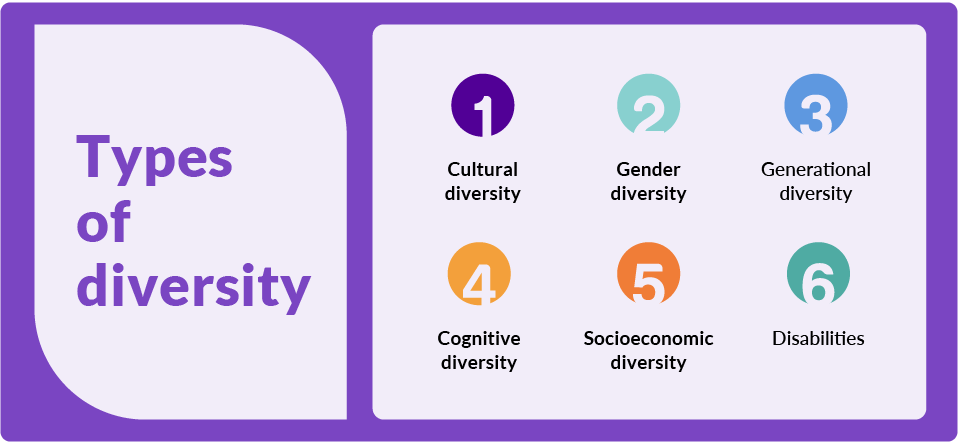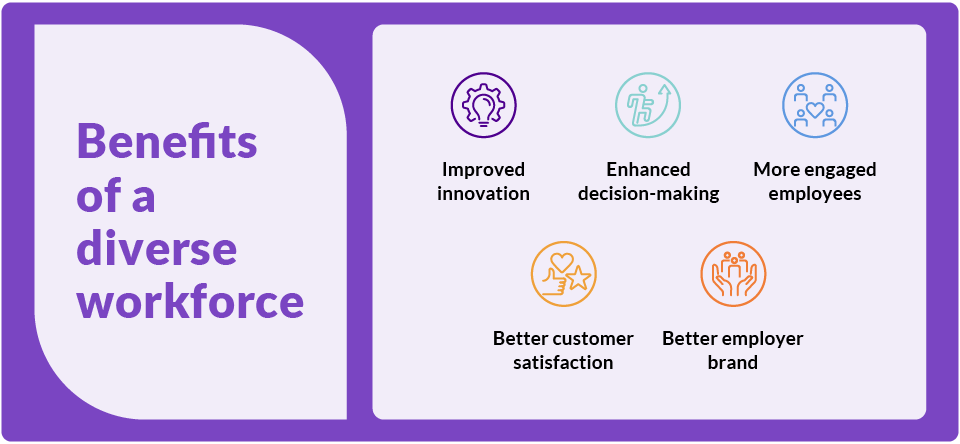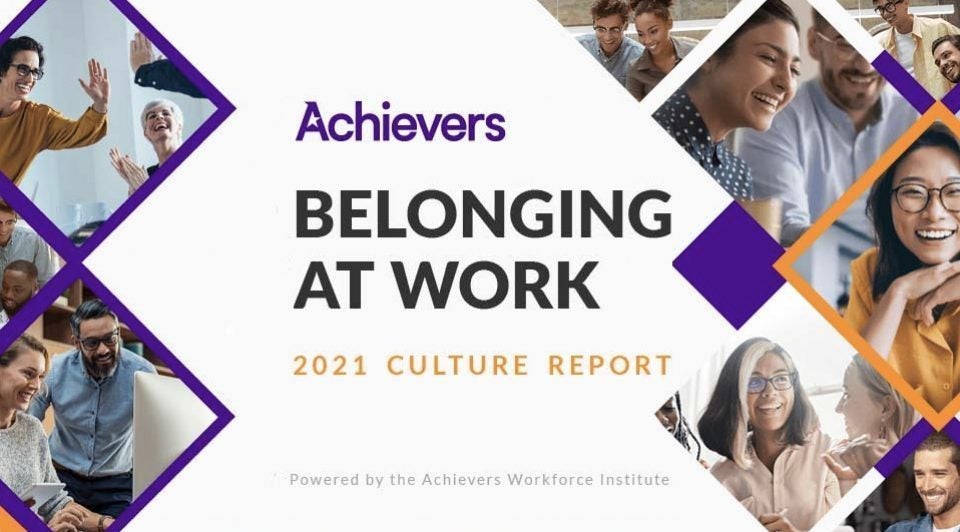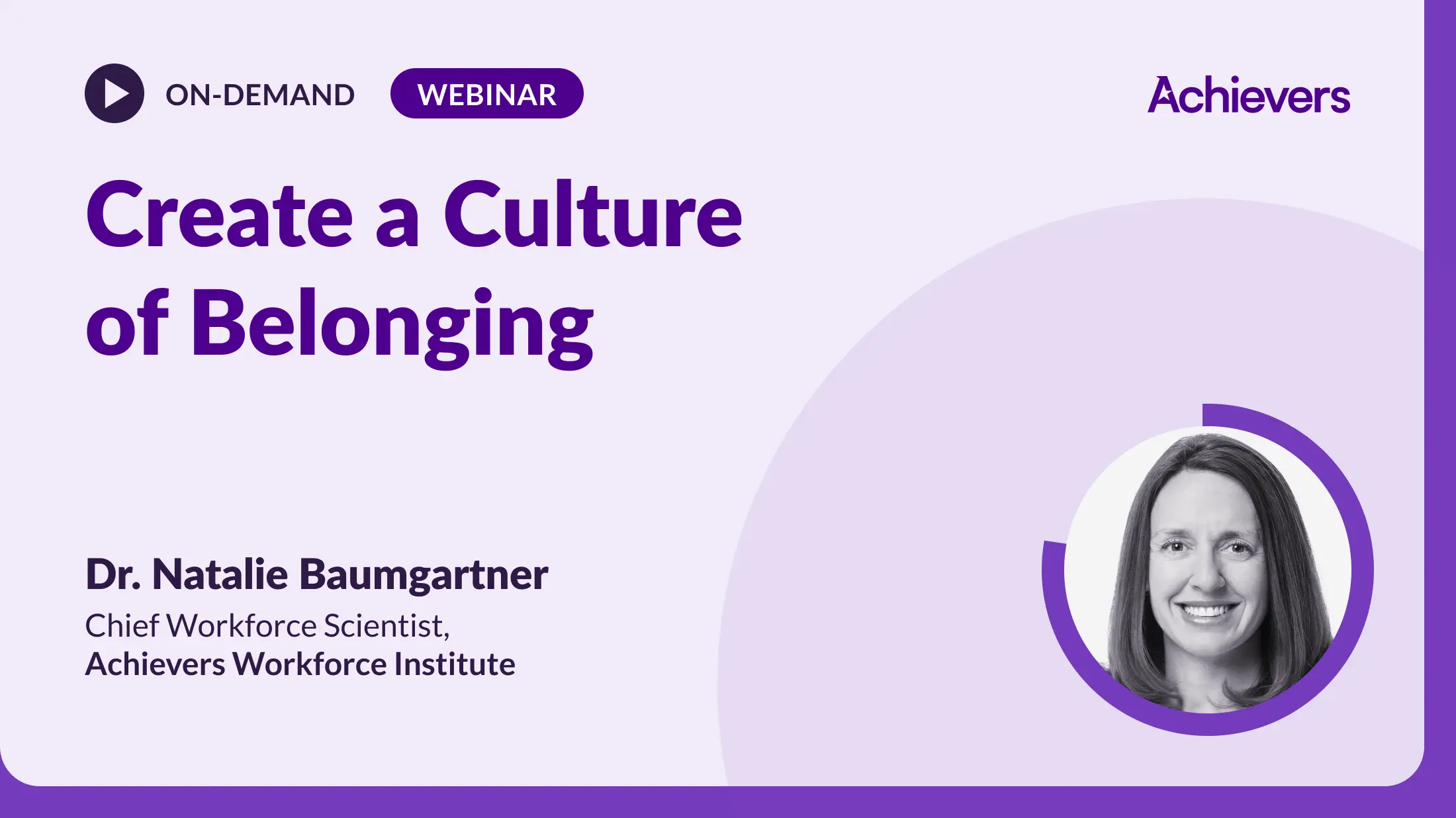Table of contents
Diversity has been incorporated into the policies and practices of organizations the world over. But despite its increasingly prominent place in the corporate and social landscape, it’s often unclear just what it means. Can diversity initiatives make a major impact at your organization, or is it just a fluffy HR term?
If you’re looking for a greater understanding of what diversity in the workplace looks like, how it can benefit your company, and which diversity initiatives to prioritize, you’re in the right place. We’ll start with a quick overview of a key phrase you’ve probably heard at least once or twice: diversity, equity, and inclusion.
What is diversity, equity, and inclusion?
Diversity, equity, and inclusion (DEI) are three vital concepts that guide modern approaches to building societies, communities, and organizations where all individuals can participate and thrive without discrimination. All three facets of DEI are interconnected and mutually reinforcing. A diverse workforce may still face inequitable circumstances on the job, while without inclusivity, even equitable access to resources and opportunities may lead to feelings of isolation and tokenism.
Let’s take a closer look at how each of DEI’s components contributes to a greater whole.
The meaning of diversity
Diversity is the recognition and embrace of the many differences that exist among individuals. It encompasses a wide range of characteristics, including race, gender, age, sexual orientation, and socioeconomic status. Organizations that embrace diversity across these categories, and others, understand that it both enriches the employee experience and contributes to business success.
The role of equity
Equity focuses on fairness and justice in the opportunities individuals have access to and the treatment they receive. It’s about ensuring that everyone gets a fair chance to succeed based on their unique needs and circumstances. Equity recognizes historical and systemic disadvantages that have affected certain groups and aims to rectify them, ensuring that all individuals have the resources and conditions necessary to thrive. Addressing equity requires proactive measures to level the playing field, providing additional support to marginalized and disadvantaged individuals.
The importance of inclusion
Inclusion involves building environments where all individuals feel respected and are empowered to contribute. It’s about fostering a sense of belonging and creating spaces where different perspectives are not only welcomed but actively sought out and integrated. Inclusive organizations ensure that people can be their authentic selves and contribute their unique insights without fear of prejudice or judgment.
What does diversity in the workplace mean?
Diversity in the workplace puts the principles of DEI into practice for the benefit of organizations and their employees. It requires an ongoing commitment to building somewhere all team members can collaborate, share ideas, and succeed while achieving both personal and business goals. DEI efforts are essential for supporting innovation, improving decision-making, and enhancing employee engagement.
Effective workplace diversity initiatives go beyond a rigid focus on superficial signifiers and metrics. They instead focus on organically fostering a culture that actually values and respects differences, enabling employees to thrive regardless of their backgrounds.

Types of diversity
There’s a nearly endless spectrum of differences that characterize individuals and groups within society, extending well beyond the visible markers of identity. Here are just some of the ways that humans express their diversity:
- Cultural diversity encompasses differences in traditions, customs, languages, and beliefs among people from various ethnic, religious, and linguistic backgrounds. It can improve organizations by exposing employees to new worldviews and practices.
- Gender diversity recognizes the continuum of gender identities beyond the binary understanding of male and female. It includes individuals who identify as transgender and non-binary.
- Generational diversity involves the differences between age groups. Each generation brings distinct values, work styles, and levels of technological literacy to the table.
- Cognitive diversity, also called neurodiversity, centers on variations in thinking styles, problem-solving approaches, and learning preferences. Embracing cognitive diversity leads to more innovative solutions and comprehensive decision-making.
- Socioeconomic diversity reflects differences in income levels, educational backgrounds, and social opportunities. It recognizes that people’s life experiences and perspectives are often shaped by their economic circumstances.
- Disability is a key aspect of diversity that encompasses variations in physical abilities and neurological conditions. Recognizing and accommodating these differences promotes inclusivity and equal participation for all.
These types of diversity, among others, emphasize the multifaceted nature of human identity and experience. Embracing diversity in all its forms enriches organizations by supporting innovation, understanding, and a sense of belonging for everyone.

Benefits of a diverse workforce
A majority of U.S. workers view DEI initiatives positively. It’s no surprise: diversity in the workplace can bring a multitude of tangible and intangible benefits that contribute to the overall success and vibrancy of an organization. Let’s take a look at some of the most important.
Improved innovation
Similar people are likely to come up with similar solutions when confronted with problems – and if those solutions don’t pan out, your organization may face significant consequences. When employees with different backgrounds, experiences, and perspectives come together, they instead bring a diverse range of ideas to the table. This leads to creative problem-solving and innovative strategies that wouldn’t have come to the fore in a more homogenous environment.
Enhanced decision-making
Diversity naturally leads to improved decision-making. A diverse workforce is better equipped to anticipate potential pitfalls and consider a wide range of factors before making critical choices. Stakeholders with a variety of viewpoints are more apt to identify and call out assumptions and biases, leading to informed decisions that have a better chance of contributing to organizational success.
More engaged employees
When employees feel welcome and empowered, knowing that their identities and contributions are truly valued, higher levels of engagement and motivation are the result. Engaged employees are more committed to the organization and invested in their work, leading to enhanced productivity and lower turnover.
Higher customer satisfaction
A workforce that mirrors the demographic diversity of the customers they serve is better able to meet their needs, anticipate their preferences, and empathize with their concerns. This naturally results in stronger customer relationships, improved customer satisfaction, and, ultimately, an improved bottom line.
A better employer brand
A strong commitment to DEI can positively impact an organization’s reputation and market competitiveness. Companies that champion diversity are often seen as socially responsible and attractive to both customers and potential employees seeking an inclusive and forward-thinking environment. In a socially conscious era, many individuals are drawn to companies that champion inclusivity and social responsibility. A diverse workforce demonstrates a commitment to equal opportunities and can attract top talent seeking a welcoming and modern work environment.
Challenges of fostering workplace diversity
Realizing the advantages of diversity in the workplace requires overcoming numerous challenges, from unconscious biases to cultural differences and more.
Unconscious bias
Despite the best intentions, individuals may hold implicit biases that affect their perceptions and decisions. These biases can influence hiring, promotions, and day-to-day interactions, negatively impacting employees through no fault of their own. Organizations should implement bias-awareness training and structured decision-making processes involving a diverse range of stakeholders to mitigate these biases and promote fairness.
Cultural differences
Managing conflicts arising from cultural differences is yet another potential hurdle. Diverse teams often bring varying approaches to problem-solving and decision-making, which may lead to misunderstandings or disagreements. Organizations should provide training in cross-cultural communication and conflict resolution to help team members navigate these issues effectively.
Lack of diversity in leadership
A lack of representation at all levels of leadership is a persistent challenge in many workplaces. Diversity exists at the lower levels of a company, but a glass ceiling prevents many types of employees from advancing beyond a certain point. Beyond hindering career progression and contributing to a lack of role models for aspiring employees, this sends a strong message that the organization’s commitment to diversity is merely superficial. Developing diversity-focused leadership programs and mentorship initiatives can help address this issue.
Ineffective initiatives
Implementing effective diversity initiatives requires more than a few announcements and perfunctory policy changes; they demand a real shift in organizational culture and attitudes. Resistance from employees who are hesitant to change their practices or perspectives, lack of commitment from leadership, and inadequate resources can all hinder the successful implementation of DEI programs.
5 ways to promote diversity in the workplace
Despite these challenges, improving diversity is within reach for any company willing to make a lasting commitment. Here are 5 concrete steps you can take to start putting DEI into practice at your organization.
1. Support employee resource groups
Employee resource groups (ERGs) – also called employee networks or affinity groups – are voluntary, employee-led groups that bring together individuals with shared characteristics, identities, or interests to provide a platform for networking, support, and advocacy. ERGs offer a range of benefits for both employees and the organization as a whole. They create a sense of belonging by providing a safe space for employees to connect, share experiences, and seek guidance from others who understand their unique perspectives. ERGs fight against a sense of isolation, especially for underrepresented groups, and are a key part of supporting a diverse, inclusive workplace.
From an organizational standpoint, ERGs offer insights into the needs and concerns of various segments of the workforce. These insights can inform additional policies, programs, and initiatives that promote diversity and inclusion. ERGs also serve as channels for feedback and suggestions, enabling the organization to make more informed decisions to address the real needs of its diverse workforce.
To support ERGs effectively, organizations should ensure they have leadership backing and sufficient resources. Encouraging an open dialogue between ERGs and organizational leadership helps align the groups’ objectives with the company’s overall diversity and inclusion goals. And providing funding, meeting spaces, and logistical support demonstrates the organization’s commitment to fostering a diverse and inclusive workplace.
Finally, ERGs must maintain an inclusive approach, welcoming all employees regardless of their background or identity. This prevents the groups from becoming exclusive or reinforcing divisions within the organization. Encourage collaboration between different ERGs as well to promote an intersectional perspective on employees’ identities and experiences.
2. Prioritize diversity during the entire recruitment process
Promoting diversity in the workplace begins with inclusive hiring practices that actively seek out and welcome candidates with a wide range of backgrounds and life experiences. To support diversity during the recruiting process, organizations can implement several strategies:
- Job descriptions should be crafted to focus on objective skills and qualifications, avoiding any gendered or biased language. This helps attract a broader pool of candidates and reduces unconscious biases during the screening process.
- Diversify recruitment channels to reach a wider applicant pool. Utilize platforms, organizations, and networks that cater to underrepresented groups to increase visibility among candidates who otherwise might miss the opportunity.
- Ensure that hiring panels are themselves diverse, and train panel members to recognize and mitigate biases.
- Structured interviews with standardized questions lead to a fairer evaluation process. They help ensure that each candidate is assessed based on the same criteria, reducing the influence of personal prejudices.
- Consider implementing blind resume reviews, where personal information is removed from resumes before they are reviewed. This focuses attention on qualifications rather than demographic details.
By taking these steps, organizations can create a more diverse and inclusive workforce from the very beginning of the recruitment process, fostering a culture of equity and respect.
3. Ensure leaders support diversity and transparency
Leaders play a crucial role in setting the tone for the organization’s culture and shaping its values. Supporting diversity in the workplace requires intentional leadership practices that promote inclusivity and create an environment where all employees can thrive. This begins with actively listening to employees’ experiences and concerns. Encouraging open dialogue and creating opportunities for feedback ensures that all voices are heard and considered in decision-making processes.
Practicing transparency is another pivotal way leaders can promote diversity in the workplace. Openness and honesty create an atmosphere of trust that encourages inclusivity and empowers employees from diverse backgrounds. Leaders should establish diversity and inclusion metrics to track progress and hold the organization accountable. These metrics might include representation at various levels, employee satisfaction, and pay equity assessments. Leaders should clearly communicate the organization’s diversity goals, progress, and action plans to all employees, demonstrating accountability and encouraging everyone to be part of the change.
Pay transparency is another aspect to consider. Clearly outlining pay structures and explaining how salaries are determined can help mitigate potential wage gaps based on gender, ethnicity, or other factors. Additionally, being transparent about unconscious biases and the steps taken to address them is crucial. Acknowledging that biases exist and discussing strategies for mitigating them fosters a culture of self-awareness and improvement.
4. Encourage coaching and mentorship
Coaching and mentorship programs can significantly contribute to fostering diversity in the workplace. These initiatives provide structured support and guidance that help underrepresented employees navigate their careers and overcome any barriers.
Mentorship involves a 1:1 relationship between a new employee and a more experienced counterpart. By establishing diverse mentorship pairs, organizations create opportunities for individuals from different backgrounds to connect and learn from one another. Mentors can offer insights, advice, and guidance, helping mentees build confidence and thrive.
Coaching is a management approach that focuses on empowering and developing individuals. It gives employees personalized guidance tailored to their specific needs, helping them enhance their skills, address challenges, and achieve their professional goals. These programs contribute to a more inclusive environment by providing underrepresented employees with access to networks, resources, and opportunities they might not have otherwise.
When starting these programs, ensure that mentors and coaches receive training on cultural competence and implicit bias. Without this education, any initiatives may do more harm than good.
5. Establish DEI training programs
Training is a pivotal tool for supporting diversity in the workplace. DEI training programs educate employees about the significance of diverse perspectives, experiences, and identities. Effective diversity training should start with the basics, providing participants with definitions and explanations of various dimensions of diversity, including but not limited to race, gender, ethnicity, sexual orientation, and age. It should emphasize the value of inclusivity, showing how diverse teams lead to enhanced innovation and better problem-solving.
Furthermore, training programs should address unconscious biases that can influence decision-making and interactions. By recognizing and confronting these biases, employees can work to mitigate their impact and create a fairer, more equitable workplace. Importantly, diversity training should be ongoing and integrated into an organization’s culture. It’s not a one-time event, but rather a continuous process that evolves with the workforce and societal changes.
Interpersonal skills training is also essential. It equips employees with the tools to communicate effectively and respectfully with colleagues from different backgrounds. This training can help prevent misunderstandings and conflicts, fostering a more harmonious and united work environment.
Start supporting diversity in your workplace today
Listening to every member of your organization’s diverse workforce, and recognizing their unique contributions and insights, is something that your company can’t afford to neglect. The Achievers Employee Experience Platform is laser-focused on helping your company build a culture of belonging. It provides every employee with the ability to deliver confidential feedback anytime, anywhere using intelligent, AI-powered channels through Achievers Listen. Leaders can then leverage the reporting and analytics features of Listen to take quick, effective action on the issues your workforce finds most pressing. And you can also supercharge recognition at your organization – the #1 driver of employee connection – with Achievers Recognize, a market-leading recognition platform backed by a best-in-class rewards marketplace.
See how Achievers can help make your company more inclusive and welcoming with a free demo.




